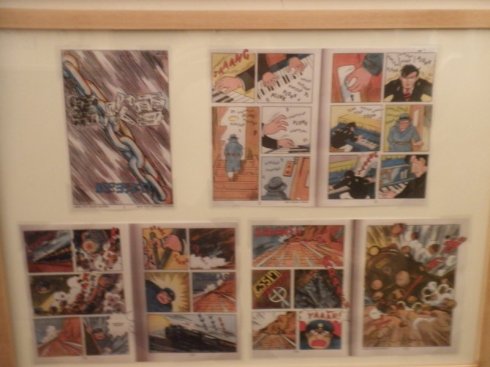We all know manga. It arrived drip-drip in the West in the ‘80s, most prominently through serialisation of the samurai epic Lone Wolf And Cub with covers by Frank Miller, and now spills across endless shelves of Forbidden Planet – everything from riotous fantasy to the exploits of super-chefs or teen tennis prodigies – as well as filling our cinemas in its animated form. But before manga arrived in the West, before it even existed in its present form in Japan, there was… Gekiga.
Gekiga is the bridge between Japanese post-war kids’ comics about wide-eyed robot children, and the astonishing variety in style and subject matter we see today. It sprung from an intuition on the part of three friends and occasional rivals that those who had grown up with comics were ready for something more adult. Ordered to share a bedsit in Osaka by their publisher to increase productivity, Masahiko Matsumoto, Yoshihiro Tatsumi and Takao Saito stayed up late into the night discussing a new visual language, based on the cinematic vision of Osamu Tezuka, the “Father of Manga”, and a new kind of storytelling, rooted in real life rather than fantasy. A new genre, they decided, needed a new name. The one that stuck was coined by Tatsumi: “Gekiga”, or “dramatic pictures”.
Those early pioneers are not well known in the West. The Wikipedia page on Gekiga does not even mention Matsumoto, whose work The Man Next Door thrilled and inspired the other two to raise their game. So it was wonderful, and not a little moving, to see Matsumoto’s son last night at the London Cartoon Museum, launching a two-month-long exhibition dedicated to Gekiga.

Tomohiko Matsumoto, son of the originator of Gekiga comics, and cartoonist Takayo Akiyama, who translated for him
“These stories are less humorous and more realistic,” explained Tomohiko Matsumoto through a translator, “which appeals more to teenagers than children. Before, it was all fantasy – a lion starts talking to you, or people come out of a rocket. My father invented the manga which formed the basis for Gekiga in 1956, then two years later Tatsumi created the name, and worked in the same concept and style. Other cartoonists begin to experiment with Gekiga, and it starts to become more normal and popular, and that is the start of manga culture as you now know it.”
I collared Matsumoto after his speech, to ask him about the influence on these pioneers of Tezuka, who created Astroboy and Kimba The White Lion (which formed the template for Disney’s The Lion King). “Good question,” said Matsumoto smilingly in English, before continuing through the translator: “Tezuka used to live on the West side of Japan, near Osaka where my father was. He gave my father a drawing, and to Tatsumi too. [The drawing given to his father, of priceless historical significance, is up on the Cartoon Museum’s wall.] They admired his work greatly; their goal was to become cartoonists like him. But when he moved to Tokyo, and started doing shorter stories, where he needed to explain the action with speech bubbles, they felt it narrowed down his expression. So they needed to create that expression for themselves.”
So successful were they that the pupils became the masters: Tezuka himself would later derive influence from the more realistic Gekiga style, most notably in Message to Adolf.
The exhibition at the London Cartoon Museum brings together over 50 pieces of original artwork and reproductions from rare manga, most never displayed before in Europe. Most interesting are pages from Tatsumi’s autobiographical manga memoir of the period, A Drifting Life, which conveys the challenge and excitement of developing a new literary movement; a series of intoxicatingly bright and pulpy noir covers; and two extraordinarily powerful black-and-white Samurai illustrations by Hiroshi Hirata, which could grace the wall of any art gallery.
As to Tomohiko’s revered father, Masahiko Matsumoto, he will finally get the British publication that in life eluded him. Four stories from the work that started it all, The Man Next Door, are being published by Breakdown Press this week – 58 years after it was written.



Misspelling: it should be Masahiko Matsumoto.
Many thanks, Ryan. Now corrected.
You missed the one in the last paragraph.
thanks again, done.